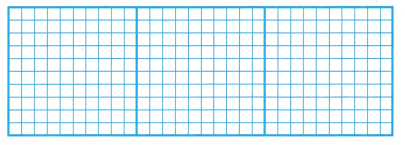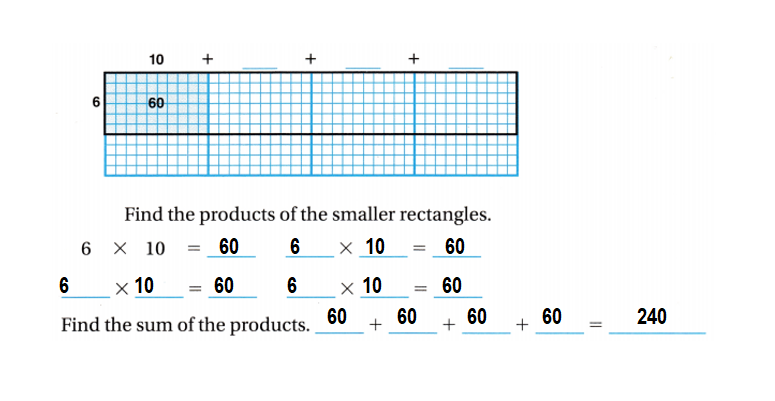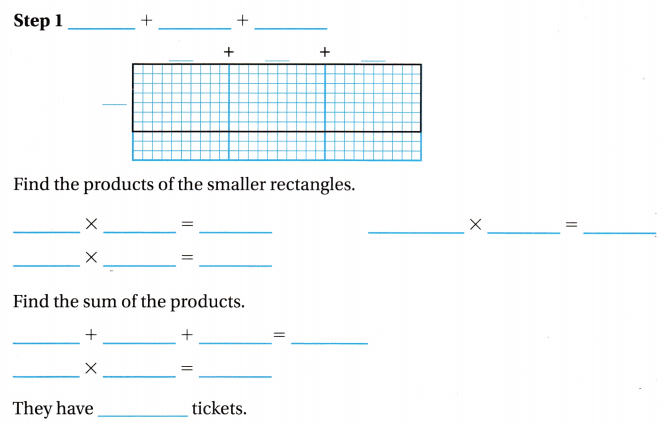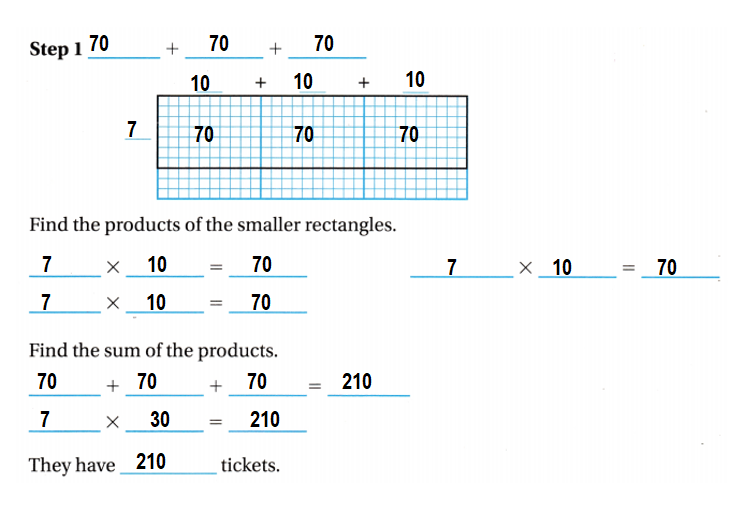Refer to our Texas Go Math Grade 3 Answer Key Pdf to score good marks in the exams. Test yourself by practicing the problems from Texas Go Math Grade 3 Lesson 9.1 Answer Key Use the Distributive Property.
Texas Go Math Grade 3 Lesson 9.1 Answer Key Use the Distributive Property
Essential Question
How can you use the strategy draw a diagram to multiply with multiples of 10?
Unlock the Problem
The school assembly room has 10 rows of chairs with 20 chairs in each row. If the third-grade classes fill 3 rows
of chairs, how many third graders are at the assembly?
Read
What do I need to find?
I need to find how many ___ are at the assembly.
What information am I given?
There are ___ chairs in each row.
The third graders fill __ rows of chairs.
Plan
What is my plan or strategy?
The Distributive Property tells me
I can ___ the factor 20 to multiply.
3 × 20 = 3 × (10 + ___)
Solve
Draw a diagram. Finish the shading to show 3 rows of 20 chairs.

I can use the sum of the products of the smaller rectangles to find how many third graders are at the assembly.
3 × 10 = ___ 3 × 10 = __
___ + ___ = ____
3 × 20 = ___
So, __ third graders are at the assembly.
Question 1.
Explain how breaking apart the factor 20 makes finding the product easier.
Answer:
Breaking apart the factor 20 makes finding the product easier because its helps to manipulate the numbers in different easy ways to get the end result in an quick and understandable way.
Explanation:
Breaking apart an addend is a mental math. This strategy involves breaking up one addend in an equation into more manageable parts. Like many other mental math strategies, this strategy encourages students to think flexibly and to manipulate numbers in different ways.
Try Another Problem
Megan is watching a marching band practice. The band marches by with 4 rows of people playing instruments. She counts 30 people in each row. How many people are marching in the band?
Read
What do I need to find?
What information am I given?
Plan
What is my plan or strategy?
Solve
Record the steps you used to solve the problem

Question 2.
Explain how you can use the Distributive Property to help you find a product.
Answer:
Distributive property helps us in finding the product as it allows you to split a large multiplication problem into two smaller ones and add the results to get the answer in an easy, simplified and understanding way.
Explanation:
The distributive property tells us how to solve expressions in the form of a(b + c). The distributive property is sometimes called the distributive law of multiplication and division.
Math talk
Mathematical Processes
Explain how you can check to see if your answer is reasonable.
Share and Show
Unlock the Problem Tips
✓ Use the Problem Solving MathBoard.
✓ Underline important facts.
✓ Choose a strategy you know.
Question 1.
The front section of a theater has 6 rows with 40 seats in each row. In the front section, 24 seats are reserved. How many seats in the front section of the theater are not reserved?
Step 1.
Write the problem you need to solve. ____
Draw and label a diagram to break apart the problem.

There are __ seats in the front section of the theater.
Step 2.
Find the difference. 240 — ___ = ___
So, there are ____ seats in the front section that are not reserved.
Answer:
Total number of seats in the front section in the theatre = 240.
Explanation:
Number of seats in the front section in the theatre = ???
Total number of rows in the theatre = 6.
Number of seats in each row in the theatre = 40.
Total number of seats in the front section in the theatre = Total number of rows in the theatre × Number of seats in each row in the theatre
= 6 × 40
= 6 × (10 + 10 + 10 + 10)
= (6 × 10) + (6 × 10) + (6 × 10) + (6 × 10)
= 60 + 60 + 60 + 60
= 120 + 60 + 60
= 180 + 60
= 240.

Question 2.
What if seats are added to the front section of the theater so that there are 6 rows with 50 seats in each row? How many seats are in the front section?
Answer:
Total number of seats in the front section in the theatre = 300.
Explanation:
If seats are added to the front section of the theater so that there are 6 rows with 50 seats in each row:
Total number of seats in the front section in the theatre = ???
Total number of rows in the theatre = 6.
Number of seats in each row in the theatre = 50.
Total number of seats in the front section in the theatre = Total number of rows in the theatre × Number of seats in each row in the theatre
= 6 × 50
= 6 × (10 + 10 + 10 + 10 + 10)
= (6 × 10) + (6 × 10) + (6 × 10) + (6 × 10) + (6 × 10)
= 60 + 60 + 60 + 60 + 60
= 120 + 60 + 60 + 60
= 180 + 60 + 60
= 240 + 60
= 300.
Problem Solving
Question 3.
H.O.T. Multi-Step Tova sewed 60 pieces of blue ribbon together to make a costume. Each piece of ribbon was 2 meters long. She also sewed 40 pieces of red ribbon together that were each 3 meters long. Did Tova use more blue ribbon or red ribbon? Explain.

Answer:
No, Tova did not use more blue ribbon nor red ribbon because she used both ribbons same amount of length.
Explanation:
Number of pieces of blue ribbon Tova sewed = 60.
Length of each piece of blue ribbon = 2 meters.
Total length of piece of blue ribbon Tova sewed = Number of pieces of blue ribbon Tova sewed × Length of each piece of blue ribbon
= 60 × 2
= 120meters.
Number of pieces of red ribbon Tova sewed = 40.
Length of each piece of red ribbon = 3 meters.
Total length of piece of red ribbon Tova sewed = Number of pieces of red ribbon Tova sewed × Length of each piece of red ribbon
= 40 × 3
= 120 meters.
Daily Assessment Task
Fill in the bubble for the correct answer choice.
Question 4.
Apply A zoo gives 8 tubs of food to the male gorillas. Each tub has 40 pounds of food. How much food do the male gorillas eat each day?
(A) 270 pounds
(B) 180 pounds
(C) 320 pounds
(D) 90 pounds
Answer:
Total weight of the tubs of food to the male gorillas Apply A zoo gives = 320 pounds.
(C) 320 pounds.
Explanation:
Number of tubs of food to the male gorillas Apply A zoo gives = 8.
Weight of each tub of food has = 40 pounds.
Total weight of the tubs of food to the male gorillas Apply A zoo gives = Number of tubs of food to the male gorillas Apply A zoo gives × Weight of each tub of food has
= 8 × 40
= (8 × 10) + (8 × 10) + (8 × 10) + (8 × 10)
= 80 + 80 + 80 + 80
= 160 + 80 + 80
= 240 + 80
= 320 pounds.
Question 5.
Marcus will make 20 omelets. Each omelet takes 3 eggs. How many eggs will Marcus use?
(A) 23
(B) 17
(C) 60
(D) 50
Answer:
Total number of eggs will Marcus use = 60.
(C) 60.
Explanation:
Number of omelets Marcus will make = 20.
Number of eggs each omelet takes = 3.
Total number of eggs will Marcus use = Number of omelets Marcus will make × Number of eggs each omelet takes
= 20 × 3
= 60.
Question 6.
Multi-Step Shania makes a scrapbook about her trip to the state capitol. She makes 2 sections about the history and 4 sections about what she saw. Each history section has 30 pages and each section about what she saw has 20 pages. How many pages does Shania’s scrapbook have?
(A) 140
(B) 300
(C) 80
(D) 60
Answer:
Total number of pages Shania scrapbooks has = 140.
(A) 140.
Explanation:
Number of sections about the history Shania makes = 2.
Number of pages each history section has = 30.
Number of pages about history Shania makes = Number of sections about the history Shania makes × Number of pages each history section has
= 2 × 30
= (2 × 10) + (2 × 10) + (2 × 10)
= 20 + 20 + 20
= 40 + 20
= 60.
Number of sections about what she saw Shania makes = 4.
Number of pages each what she saw section has = 20.
Number of pages about what she saw Shania makes = Number of sections about what she saw Shania makes × Number of pages each what she saw section has
= 4 × 20
= 80.
Total number of pages Shania scrapbooks has = Number of pages about history Shania makes + Number of pages about what she saw Shania makes
= 60 + 80
= 140.
Texas Test Prep
Question 7.
Stefan orders theater tickets for each of the 5 members in his family. If each ticket costs $20, what is the total cost for the tickets?
(A) $70
(B) $30
(C) $25
(D) $100
Answer:
Total cost for the tickets = $100.
(D) $100.
Explanation:
Number of members in the family of Stefan = 5.
Cost of each ticket = $20.
Total cost for the tickets = Number of members in the family of Stefan × Cost of each ticket
= 5 × $20
= $100.
Texas Go Math Grade 3 Lesson 9.1 Homework and Practice Answer Key
Draw and label the diagram to solve.
Question 1.
The Morgan family buys 7 booklets of tickets at the carnival. Each booklet has 30 tickets. Of all the tickets bought, 21 tickets are for rides. How many tickets are not for rides?

Step 2
Find the differences. 210 – ___ = ___
So, there are __ tickets that are not for rides.
Answer:
Number of tickets are not for rides = 189.
Explanation:
Number of booklets of tickets at the carnival the Morgan family buys = 7.
Number of tickets each booklet has = 30.
Total number of tickets booklet has = Number of booklets of tickets at the carnival the Morgan family buys × Number of tickets each booklet has
= 7 × 30
= (7 × 10) + (7 × 10) + (7 × 10)
= 70 + 70 + 70
= 140 + 70
= 210.
Number of tickets are for rides = 21.
Number of tickets are not for rides = Total number of tickets booklet has – Number of tickets are for rides
= 210 – 21
= 21( 10 – 1)
= 21 × 9
= 189.

Problem Solving
Question 2.
The roller coaster ride costs 8 tickets. If 30 people ride the roller coaster, how many tickets are collected?
___ × ___ = ____
Answer:
Number of tickets are collected = 240.
8 × 30 = 240.
Explanation:
Number of tickets the roller coaster ride costs = 8.
Number of people ride the roller coaster = 30.
Number of tickets are collected = Number of tickets the roller coaster ride costs × Number of people ride the roller coaster
= 8 × 30
= (8 × 10) + (8 × 10) + (8 × 10)
= 80 + 80 + 80
= 160 + 80
= 240.
Question 3.
The giant swing ride costs 6 tickets. If 50 people ride the giant swing ride, how many tickets are collected?
___ × ___ = ____
Answer:
Number of tickets are collected = 300.
6 × 50 = 300.
Explanation:
Number of tickets the giant swing ride costs = 6.
Number of people ride the giant swing ride = 50.
Number of tickets are collected = Number of tickets the giant swing ride costs × Number of people ride the giant swing ride
= 6 × 50
= (6 × 10) + (6 × 10) + (6 × 10) + (6 × 10) + (6 × 10)
= 60 + 60 + 60 + 60 + 60
= 120 + 60 + 60 + 60
= 180 + 60 + 60
= 240 + 60
= 300.
Texas Test Prep
Lesson Check
Fill in the bubble completely to show your answer.
Question 4.
An has a rock collection. He puts 20 rocks into each of 8 boxes. How many rocks does An have in his collection?
(A) 160
(B) 28
(C) 16
(D) 140
Answer:
Number of rocks An have in his collection = 160.
(A) 160.
Explanation:
Number of rocks An has in his rock collection = 20.
Number of boxes = 8.
Number of rocks An have in his collection = Number of rocks An has in his rock collection × Number of boxes
= 20 × 8
= (10 × 8) + (10 × 8)
= 80 + 80
= 160.
Question 5.
At the town picnic, there are 7 stacks of paper cups on a shelf. Each stack holds 60 cups. How many cups are on the shelf?
(A) 490
(B) 420
(C) 670
(D) 67
Answer:
Number of cups are on the shelf = 420.
(B) 420.
Explanation:
Number of stacks of paper cups on a shelf = 7.
Number of cups each stack holds = 60.
Number of cups are on the shelf = Number of stacks of paper cups on a shelf × Number of cups each stack holds
= 7 × 60
= (7 × 10) + (7 × 10) + (7 × 10) + (7 × 10) + (7 × 10) + (7 × 10)
= 70 + 70 + 70 + 70 + 70 + 70
= 140 + 70 + 70 + 70 + 70
= 210 + 70 + 70 + 70
= 280 + 70 + 70
= 350 + 70
= 420.
Question 6.
Mr. Franz buys 4 bags of forks. There are 30 forks in each bag. Which number sentence shows how many forks are there in all?
(A) 4 + 30 = 34
(B) 4 × 30 = 120
(C) 4 + 30 = 120
(D) 40 + 30 = 70
Answer:
Number of forks are there in all = 120.
(B) 4 × 30 = 120.
Explanation:
Number of bags of forks Mr. Franz buys = 4.
Number of forks in each bag = 30.
Number of forks are there in all = Number of bags of forks Mr. Franz buys × Number of forks in each bag
= 4 × 30
= (4 × 10) + (4 × 10) + (4 × 10)
= 40 + 40 + 40
= 80 + 40
= 120.
Question 7.
Valerie buys 5 sticker books. Each book has 80 stickers. Which number sentence shows how many stickers Valerie buys?
(A) 5 × 80 = 40
(B) 8 + 50 = 58
(C) 5 × 80 = 400
(D) 5 × 80 = 450
Answer:
Number of stickers Valerie buys = 400.
(C) 5 × 80 = 400.
Explanation:
Number of sticker books Valerie buys = 5.
Number of stickers each book has = 80.
Number of stickers Valerie buys = Number of sticker books Valerie buys × Number of stickers each book has
= 5 × 80
= (5 × 10) + (5 × 10) + (5 × 10) + (5 × 10) +(5 × 10) + (5 × 10) + (5 × 10) + (5 × 10)
= 50 + 50 + 50 + 50 + 50 + 50 + 50 + 50
= 100 + 50 + 50 + 50 + 50 + 50 + 50
= 150 + 50 + 50 + 50 + 50 + 50
= 200 + 50 + 50 + 50 + 50
= 250 + 50 + 50 + 50
= 300 + 50 + 50
= 350 + 50
= 400.
Question 8.
Multi-Step A farm stand has 4 bushels of apples. Each bushel has 40 red apples. There are also 7 bushels of 30 green apples. How many apples are there in all?
(A) 490
(B) 370
(C) 280
(D) 160
Answer:
Total number of apples in all = 370.
(B) 370
Explanation:
Number of bushels of apples a farm stand has = 4.
Number of red apples in each bushel has = 40.
Total number of red apples = Number of bushels of apples a farm stand has × Number of red apples in each bushel has
= 4 × 40
= (4 × 10) + (4 × 10) + (4 × 10) + (4 × 10)
= 40 + 40 + 40 + 40
= 80 + 40 + 40
= 120 + 40
= 160.
Number of bushels of green apples a farm stand has = 7.
Number of green apples in each bushel has = 30.
Total number of green apples = Number of bushels of green apples a farm stand has × Number of green apples in each bushel has
= 7 × 30
= (7 × 10) + (7 × 10) + (7 × 10)
= 70 + 70 + 70
= 140 + 70
= 210.
Total number of apples in all = Total number of red apples + Total number of green apples =
= 160 + 210
= 370.
Question 9.
Multi-Step Marcel buys 3 large boxes of cherries. Each box holds 40 cherries. He also buys 8 small boxes. Each small box holds 20 cherries. How many cherries does Marcel buy?
(A) 280
(B) 120
(C) 480
(D) 160
Answer:
Total number of cherries in all he buys = 280.
(A) 280.
Explanation:
Number of large boxes of cherries Marcel buys = 3.
Number of cherries each box holds = 40.
Total number of cherries in large boxes = Number of large boxes of cherries Marcel buys × Number of cherries each box holds
= 3 × 40
= (3 × 10) + (3 × 10) + (3 × 10) + (3 × 10)
= 30 + 30 + 30 + 30
= 60 + 30 + 30
= 90 + 30
= 120.
Number of small boxes of cherries Marcel buys = 8.
Number of cherries each box holds = 20.
Total number of cherries in small boxes = Number of small boxes of cherries Marcel buys × Number of cherries each box holds
= 8 × 20
= (8 × 10) + (8 × 10)
= 80 + 80
= 160.
Total number of cherries in all he buys = Total number of cherries in large boxes + Total number of cherries in small boxes
= 120 + 160
= 280.